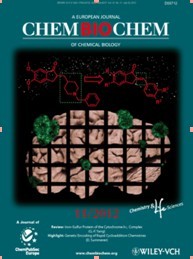The cover picture shows fluorescent microscope images (green) of amyloid plaques stained by indanone derivatives that were designed from donepezil. Using molecular imaging probes to detect senile plaques might help the early diagnosis of Alzheimer's disease (AD). J.-N. Zhou et al. describe how they synthesized and characterized a novel series of indanone derivatives. The in vitro binding studies, staining of Alzheimer's disease (AD) brain sections, autoradiography, and biodistribution data all suggested that these derivatives might represent potential amyloid imaging agents for the detection of senile plaques in AD.

Abstract
Molecular imaging probes to detect senile plaques (SPs) might help the early diagnosis of Alzheimer's disease (AD). In this study, a novel series of indanone derivatives were synthesized and characterized. In in vitro binding studies, compound 2 e exhibited a Ki value of 16 nM with a human AD brain homogenate. Although they displayed relatively low affinities for 2 i and 2 j—with Ki values of 99 and 237 nM, respectively—the SPs in AD brain sections were positively stained by 2 j. A method for in situ micro-autoradiography of AD brain was developed in this study and showed clear labeling of SPs by [125I]2 i and [125I]2 j. Both [125I]2 i and [125I]2 j had suitable lipophilicities and displayed high initial uptake and rapid clearance from the mouse brains. Furthermore, [125I]2 i and [125I]2 j were more stable in human brain homogenates than in mouse brain homogenates. These data suggest that such indanone derivatives might represent potential amyloid imaging agents for the detection of SPs in AD.
